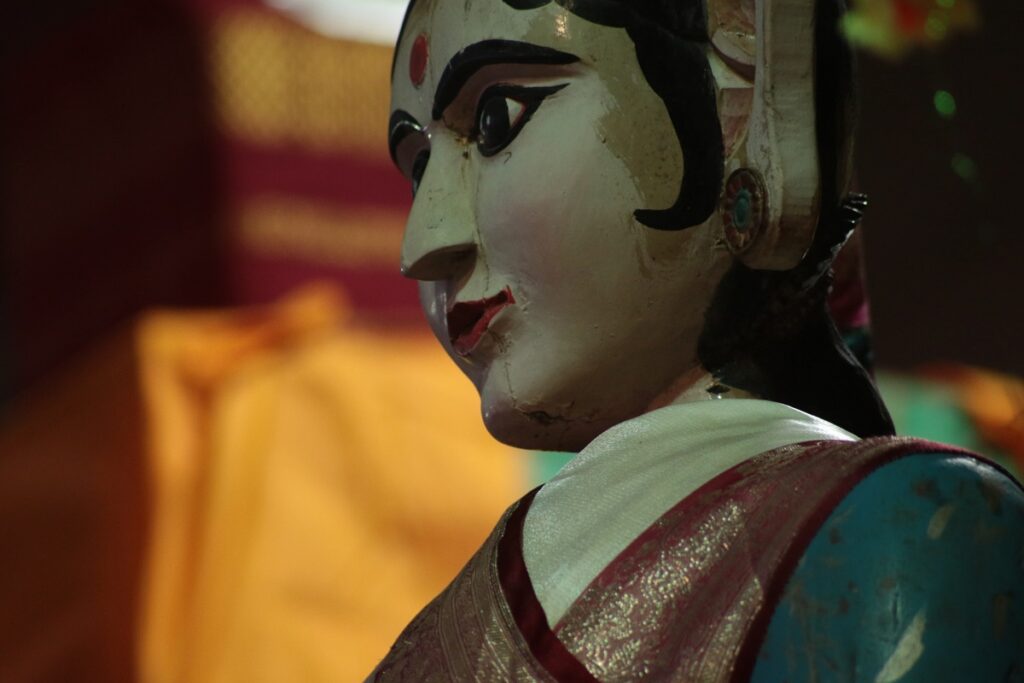Folk orchestra, loud dialogue, theatre, and dance are very powerful ways to recount the social and political story of a country’s history. One such vigorous form of entertainment for people of rural West Bengal is Jatra.

Origins of Jatra
Jatra, intrinsically a musical theatre form, is considered one of the traditional folk theatres celebrated in the Eastern locale of India. Originally, the word Jatra means journey or going. The ascent of Jatra as a high velocity and boisterous folk opera started centuries ago as an offshoot of the Bhakti Movement and reached its peak during the 1960s and 1970s.
The foundation of Jatra lies in the 16th century Krishna Jatra in Bengal. It evolved through devotional singing and dancing of the followers of the Krishna Bhakti Movement. It is still carried out on a large scale. Jatra is associated with the ceremony performed before starting a new journey.
Jatra evolved its idiom in religious processions (yatras) of devotees that moved from one place to another singing tunes of kirtan. This movement gradually moved to Urban areas and brought literacy among rural masses.
Jatra Dance
It turned into a popular folk in various Indian states like Odisha, Bihar, Assam, and Tripura including parts of Bangladesh. Jatra dance in Bihar is one of the central dance forms of the significant ancestral populace of the state. It portrays the counterfeit battle between people of one village with others using long poles surmounted by pennants and waving sticks.
Performance and Ambience
Initially, Jatra grew into a satirical account of oppression under British rule. However, it soon assumed the role of a tool of protest, and there lies the beauty of Jatra. It unfolds on a raised platform surrounded by the audience. Jatra performance captures the imagination while delivering the message with vibrant storytelling. It creates an astounding impact and punch. The performances are accompanied with a full-powered orchestra especially on the horns, strings, wind and percussion instruments.
However, in the early 80s, the cultural tradition went through marked changes when Jatra dance, an inseparable part of the show, proceeded towards decline and virtually turned into striptease. There was a time when Jatra traveling troupes would leave entire villages in Bengal enthralled and enraptured with their performances. And their dramatic interpretations of religious myths and socio-political stories received adulation all over Bengal. The zamindars would invite troupes to perform during festivals and ceremonies. Jatra actors were the celebrities of their times and unfortunately, today, they are a forgotten lot.
The Downfall
Now, the amateur artform seems beyond salvation due to its commercialization. It has become exploitative sexually, mentally, and financially for performers, especially women, who often live an inhuman life with no social recognition.
Due to its transformation into a cheap form of sexual entertainment, this cultural heritage of West Bengal is at risk of losing its authenticity. From the hundreds of Jatra troupes sprinkled across Bengal during the nineties, only a few remain now to represent the art. As cinema and television grew, Jatra’s slow but steady decline began. Most of the celebrated Jatra performers gave up their passions for other gigs. Some became ferry operators, and a few others photo studio owners. All that was left of Jatra for them was the memories of past glory and fame.

Pingback: All Folk Dances of India - Auchitya